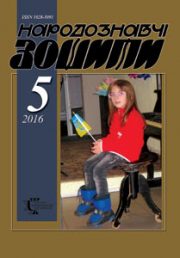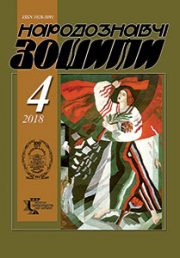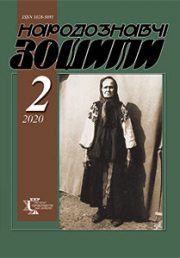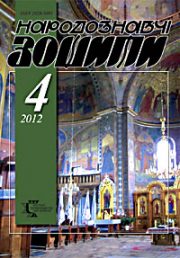The Ethnology Notebooks. 2019, № 6 (150), 1393—1407
UDK7.045:762.11:82-141(477)”16-17″
DOI https://doi.org/10.15407/nz2019.06.1393
GYRIC ENGRAVING OF THE XVIITH — THE FIRST HALF OF THE XVIIITH CENTURY
ZAVARYNSKA Khrystyna
ORCID ID: https://orcid.org/0000-0003-4926-8430
Research Assistant at the
Lviv National Academy of Arts
79011, Ukraine, Lviv, Kubiyovycha str., 38
e-mail: chrystyna.zavarynska@gmail.com
Abstract. The study of the interrelation of verbal and visual components of the panegyric, which reveals certain correspondences between different elements of the image and the literary text that they complement, while agreeing with the «loci», assigned in rhetorical theory for person’s praise, remains among the principal and relevant problems in the research of Ukrainian panegyric engraving of the 17th—18th centuries. In particular, we imply a model for constructing a panegyric text, based on the tactics of the comparison between the praised person’s virtues and actions and was visually embodied in personifications, among which engravers most often choose the figures of cardinal and theological virtues.
The objective of this article is to analyze the iconographical features of the virtues’ personifications in Ukrainian panegyric engraving of the 17th — the first half of the 18th century on the basis of comparison with the main iconographic variants of such allegories in Western European graphic art and theoretical treatises of that period. The current research requires the use of several methods of art historical analysis, among them context analysis, which aims at distinguishing the function and significance of the artistic work in the period it was created. The central methodological approach to the study of the personifications of virtues is the iconographic analysis, which allows to highlight the peculiar features of each figure, considering their attributes, and taking into account their possible connection with other visual images and texts.
After a thorough analysis of both visual and textual material, we can draw certain conclusions, for example that the allegories and symbols of virtues in academic thesis prints and panegyric illustration visualize some universal ethical models, formed within the rhetorical guidelines for the glorification of secular rulers and clergy. Moreover, the praise of virtue in engravings is presented as a peculiar formula, that combines allegorical figures from the canon of cardinal and theological virtues, as well as other semantically related personifications and mythological figures, which correspond with verbal panegyric formulas like «Religione pro Deo, Sapientia pro patria» or «Prudentia/Sapientia et Fortitudo».
Keywords: personification, cardinal and theological virtues, iconography, panegyric engraving, academic thesis prints, heraldic poetry.
Received 12.11.2019
REFERENCES
Melion, W.S., & Ramakers, B.A. (Ed.). (2016). Personification: Embodying Meaning and Emotion. Leiden; Boston: Brill.
Ljuta, T. (2012). St. Sophia Cathedral in the Mogilaean context of the Mazepa era. NaUKMA Research Papers. History (Vol. 130, pp. 14—23) [in Ukrainian].
Fomenko, D., Cynkovs’ka, I., & Juhymec’, G. (2014). Copper engraving boards of Ukrainian printing houses of the 17th—19th centuries in the Vernadsky National Library of Ukraine. Kyiv: Akademperiodyka [in Ukrainian].
Stepovyk, D. (1986). Leontij Tarasevych and Ukrainian baroque art. Kyiv: Naukova dumka [in Ukrainian].
Triod’ cvetnaja (1609). Vil’no: drukarnja Leontija Mamonycha. Retrieved from: http://litopys.org.ua/ukrpoetry/anto13.htm (Last accessed: 10.08.2019) [in Old Slavonic].
Trankvilion-Stavrovec’kyj, K. (1618). Sia kniga naricajemaja Zercalo bogosloviy, izbranna ot mnogyh knyg bogoslovskyh y trudoljubijem sostavlena jeromonaha Kyryla Trankvelyona y propovednyka slova Bozhia, jego vlasnym koshtom y nakladom vydrukovana. Pochai’v. Retrieved from: http://litopys.org.ua/ukrpoetry/anto31.htm (Last accessed: 10.08.2019) [in Old Slavonic].
Trankvilion-Stavrovec’kyj, K. (1619). Jevangelije uchytel’noje, albo Kazanja na nedelja prez rok y na praznyky Gospodskije y narochytyy svjatym ugodnykom Bozhiym. Rahmaniv. Retrieved from: http://litopys.org.ua/ukrpoetry/anto31.htm (Last accessed: 10.08.2019) [in Old Slavonic].
Lear, F.S. (1942). Patriotism and Some Related Aspects of Roman Character. Western Tradition from Rome to Britain. Part of The Rice Institute Pamphlet, 4 (Vol. 29, pp. 257—290).
Apostol tetr, syrech Dejanija y poslanija Hrystovyh svjatyh bozhestvennyh apostol (1630). Kyiv: drukarnja Spyrydona Sobolja. Retrieved from: http://litopys.org.ua/ukrpoetry/anto41.htm (Last accessed: 10.08.2019) [in Old Slavonic].
Jevangelije uchytel’noje, albo Kazanja na nedelja prez rok y na praznyky Gospodskije y narochytyy svjatym ugodnykom Bozhiym (1637). Kyiv. Retrieved from: http://litopys.org.ua/ukrpoetry/anto51.htm (Last accessed: 10.08.2019) [in Old Slavonic].
Nalyvajko, D. (1607). Lekarstvo na ospalyj umysl cholovechij. Ostrog. Retrieved from: http://litopys.org.ua/old14_16/old14_37.htm#fil4 (Last accessed: 10.08.2019) [in Old Slavonic].
Jevangelije uchytelnoje, albo Kazanja na kazhduju nedelju y svjata urochystyy. (1616). Jev’je. Retrieved from: http://litopys.org.ua/ukrpoetry/anto21.htm (Last accessed: 10.08.2019) [in Old Slavonic].
Zemka, T. (1627). Leksikon slavenorosskij y ymen tlkovanije. Kyiv: drukarnja Kyjevo-Pechers’kogo monastyrja. Retrieved from: http://litopys.org.ua/ukrpoetry/anto39.htm (Last accessed: 10.08.2019) [in Old Slavonic].
Zemka, T. (1624). Psaltyr blazhennago proroka y carja Davyda s pesnmy y psalmy yzbrannymy na prazdnyky Gospodskija y svjatyh Bozhiyh, y s pashalijeju s molytvamy. Kyiv: Drukarnja Kyjevo-Pechers’kogo monastyrja. Retrieved from: http://litopys.org.ua/ukrpoetry/anto39.htm (Last accessed: 10.08.2019) [in Old Slavonic].
Trankvilion-Stavrovec’kyj, K. (1646). Perlo mnogocennoje. Chernigiv: Drukarnja Jelec’kogo monastyrja. Retrieved from: http://litopys.org.ua/ukrpoetry/anto32.htm (Last accessed: 10.08.2019) [in Old Slavonic].
Prosfonyma. Pryvit preosvjashhennomu arhijepyskopu kyr Myhajlu. (1591). L’viv: Drukarnja bratstva. Retrieved from: http://litopys.org.ua/old14_16/old14_33.htm (Last accessed: 10.08.2019) [in Old Slavonic].
Rymsha, A. (1588). Statut Velykogo knjazhestva Lytovskago. Vil’no: Drukarnja Mamonychiv. Retrieved from: http://litopys.org.ua/old14_16/old14_29.htm (Last accessed: 10.08.2019) [in Old Slavonic].
Stevenson, T.R. (2010). Personifications on the Coinage of Vespasian (AD 69—79). Acta Classica (Vol. LIII, pp. 181—205).
Cicero. (1949). De inventione. De optimo genere oratorum. Topica. London: William Heinemann (Loeb Classical Library).
Gerards-Nelissen, I. (1971). Otto van Veen’s Emblemata Horatiana. Simiolus: Netherlands Quarterly for the History of Art, 1/2 (Vol. 5, pp. 20—63).
Packard, A.L. (2013). The Catafalque of Paul V: Architecture, Sculpture and Iconography. PhD Dissertation. Columbia University Retrieved from: https://academiccommons.columbia.edu/catalog/ac:161619 (Last accessed: 10.08.2019).
Norena, C. (2001). The Communication of the Emperor’s Virtues. The Journal of Roman Studies (Vol. 91, pp. 146—168).
Wallace-Hadrill, A. (1981). The Emperor and his Virtues. Historia: Zeitschrift fьr Alte Geschichte, 3. 3rd qtr. (Vol. 30, pp. 298—323).
Shamos, G. (2015). Bodies of Knowledge: The Presentation of Personified Figures in Engraved Allegorical Series Produced in the Netherlands, 1548—1600. Thesis for the degree of Doctor of Philosophy. Philadelpia.
Jecker, M. (2014). The Intellectual Virtues (Nicomachean Ethics, Book VI) in Three Works of Popularization of Aristotelian Thought. SVMMA, 3, 161—175.
Bejczy, I.P., & Bejczy, I. (2011). The Cardinal Virtues in the Middle Ages: A Study in Moral Thought from the Fourth to the Fourteenth Century. Leiden: Brill.
Magirus, J. (1842). Joannis Magiri, professoris quondam inclyti, in Aristotelis Ethica Nicomachea Commentationes. Oxonii: Typis J. Vincent [in Latin].
Ciceron, Mark Tullij. (1975). O starosti. O druzhbe. Ob objazannostjah. Moskva: Nauka. Retrieved from: http://ancientrome.ru/antlitr/t.htm?a=1423775001 (Last accessed: 10.08.2019) [in Russian].
Di Biase, C. (2013, november). The Development of the Concept of Prudentia in Locke’s Classification of Knowledge. Society and Politics, 2 (Vol. 7, pp. 85—125.
Comenius, J.A. (1669). Joh. Amos Comenii Orbis sensualium pictus, hoc est, omnium fundamentalium in mundo rerum, et in vitв actionum, pictura et nomenclatura. Noribergae [in Latin].
Kowzan, J. (2014). Prudence, looking-glass and the last things. About the Emblem 96 of Zbigniew Morsztyn. Terminus, 3 (32) (Vol. 16, pp. 323—350) [in Polish].
Roberts, H. (Ed.). (2013). Encyclopedia of Comparative Iconography: Themes Depicted in Works of Art. Chicago: Routledge.
Ripa, C. (1613). Iconologia: nella quale si descriuono diuerse imagini di virtщ, vitij, affetti, passioni humane, arti, discipline, humori, elementi, corpi celesti, prouincie d’Italia, fiumi, tutte le parti del mondo, ed altere infinite materie. Siena: appresso gli heredi di Matteo Florimi [in Italian].
Mattingly, H. (1930). Coins of the Roman Empire in the British Museum (Vol. II). Vespasian to Domitian. London: Oxford University Press.
Clark, M.E. (1983). Spes in the Early Imperial Cult: «The Hope of Augustus». Numen (Vol. 30, fasc. 1, pp. 80—105).
Pokora, J. (2005). Deo & Patriae. Portraits of bishops-chancellors of the Polish Commonwealth in the 17th—18th centuries. Biuletyn historii sztuki, 3—4, 223—241 [in Polish].







